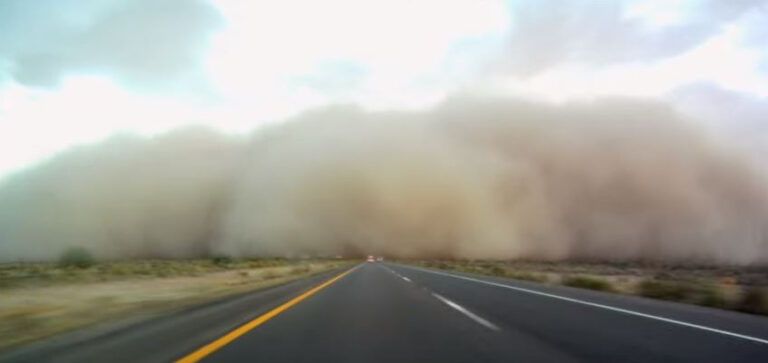A new first-of-its-kind detection and warning system has been deployed on a section of Interstate 10 in Arizona in an area that has seen numerous serious crashes due to it being prone to sudden and severe dust storms.
When blowing dust reduces visibility along 10 miles of I-10 between Eloy and Picacho Peak, a new detection and warning system developed by the Arizona Department of Transportation (ADOT) will quickly tell drivers to reduce speed for safety. ADOT is currently completing the installation of sensors, overhead message boards, variable speed limit signs, speed-feedback signs and closed-circuit cameras to create this unique dust storm detection and warning system. The prototype system is expected to begin operating in the next few weeks between mileposts 209 and 219. Those entering this stretch of I-10 will see signs saying ‘Caution: Variable Speed Limit Corridor’, which alerts drivers to a key part of the new system: programmable signs that can instantly reduce the legal speed limit.
Placed every 1,000 feet (305m) for the first mile in each direction and then every two miles (3.2km), the variable speed limit signs can change from 75mph (120km/h) to as slow as 35mph (56km/h) when there is blowing dust. Electronic message boards placed five miles (8km) apart in the pilot area will alert drivers to blowing dust, while ADOT traffic operators can use overhead message boards on the way toward the dust detection zone to warn drivers of potentially hazardous conditions ahead. Closed-circuit TV cameras will allow staff at ADOT’s Traffic Operations Centre (TOC) in Phoenix to see the real-time conditions on the roadway, while in-pavement sensors will report the speed and flow of traffic.
Along with the threat from monsoon storms in the summer and autumn, conditions on this stretch of I-10 are such that strong wind any time of the year can suddenly produce localized dust that severely reduces visibility; a phenomenon known as a ‘dust channel’. The warning system also includes weather radar, which will be mounted on a 20-foot (6m) tower at the State Route 87 interchange in Eloy, that can detect storms more than 40 miles (64km) away. This radar will complement 13 sensors mounted on posts next to the freeway that use beams of light to determine the density of dust particles in the air. In addition to enhancing safety by providing earlier warnings about blowing dust, the innovative new US$6.5m system will advance ADOT’s understanding of whether similar technology can be effective in other locations around Arizona.





